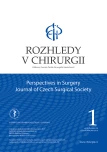Current management of diffuse peritonitis – is postoperative continuous lavage still a relevant method of choice?
Authors:
P. Špička 1; A. Gryga 2; T. Malý 1; Č. Neoral 1
Authors‘ workplace:
I. chirurgická klinika Fakultní nemocnice a Lékařské fakulty Univerzity Palackého, Olomouc
1; Chirurgické oddělení nemocnice Prostějov, SMN, a. s., člen skupiny Agel
2
Published in:
Rozhl. Chir., 2019, roč. 98, č. 1, s. 18-22.
Category:
Original articles
Overview
Introduction:
Diffuse peritonitis is a serious disease with rather poor therapeutic results. Management traditionally consists in the surgical treatment of its etiology, combined with targeted antibiotic therapy and complex intensive care of the patient. The basic procedure includes the identification and treatment of the origin of peritonitis, followed by thorough abdominal cavity toilet, lavage and drainage. There are currently two major procedures for carrying out complex surgical care of a patient suffering from diffuse peritonitis. The first one is primary sanation of the abdominal cavity, in which toilet, peroperative lavage and postoperative drainage is performed. The second procedure involves similar steps, but postoperative irrigation with saline or another solution is performed, usually over 24−48 hours – continuous lavage. Both procedures, albeit often modified, are still used in most surgical departments in the Czech Republic; therefore, we decided to compare them in terms of morbidity, mortality and hospital length of stay.
Method:
We conducted a prospective randomized study involving 55 patients with peritonitis operated on from 10/2012 to 4/2014. Whenever possible, we tried to use both methods alternately method regularly to enable randomization and ensure presentable outcomes.
Results:
No statistically significant difference related to morbidity, mortality and hospital length of stay was recorded in our group.
Conclusion:
Based on our results, we can state that both methods are equal and suitable for all types of diffuse peritonitis without any impact on mortality, morbidity and hospital length of stay.
Key words:
peritonitis – drainage − peritoneal lavage
Sources
-
Leiboff AR, Soroff HS. The treatment of generalized peritonitis by closed postoperative peritoneal lavage. A critical review of the literature. Arch Surg 1987;122:1005−10.
-
McKenna JP, Currie DJ, MacDonald JA, et al. The use of continuous postoperative peritoneal lavage in the management of diffuse peritonitis. Surg Gynecol Obstet 1970;130:254−8.
-
Winkeltau G, Winkeltau GU, Klosterhalfen B, et al. [Differential surgical therapy in diffuse peritonitis]. In German. Chirurg 1992;63:1035−40.
-
Fischer J, Bachleda P, Fischer M. [Postoperative lavage in diffuse peritonitis] In Czech Rozhl Chir 1986;65:465−71.
-
Hallerbäck B, Andersson C, Englund N, et al. A prospective randomized study of continuous peritoneal lavage postoperatively in the treatment of purulent peritonitis. Surg Gynecol Obstet 1986;163:433−6.
-
O’Brien PE, Tait N, Bushell M. Management of diffuse peritonitis by prolonged postoperative peritoneal lavage. Aust N Z J Surg 1987;57:181−4.
-
Schwarz A, Bölke E, Peiper M, et al. Inflammatory peritoneal reaction after perforated appendicitis: continuous peritoneal lavage versus non lavage. Eur J Med Res 2007;12:200−5.
-
Berger D, Buttenschoen K. Management of abdominal sepsis. Langenbecks Arch Surg 1998;383:35−43.
-
Jennings WC, Wood DC, Guernsey JM. Continuous postoperative lavage in the treatment of peritoneal sepsis. Dis Colon Rectum 1982;25:641−3.
-
Kumar GV, Smile SR, Sibal RN. Postoperative peritoneal lavage in generalised peritonitis. Prospective analysis. Int Surg 1989;74:20−2.
-
Balafa O, Halbesma N, Struijk DG, et al. Peritoneal albumin and protein losses do not predict outcome in peritoneal dialysis patients. Clin J Am Soc Nephrol 2011;6:561−6.
-
Dong J, Chen Y, Luo S, et al. Peritoneal protein leakage, systemic inflammation, and peritonitis risk in patients on peritoneal dialysis. Perit Dial Int 2013;33:273−9.
-
Rivlin ME, Hunt JA, Rubin A. Continual postoperative antibiotic peritoneal lavage in diffuse peritonitis complicating cesarean section. J Reprod Med 1984;29:173−8.
-
Antos F Leffler J, Nahodil V. [Advantages of Noxyflex in the treatment of severe diffuse peritonitis.] In Czech. Rozhl Chir 1986;65:472−5.
-
Woltmann A, Schult M, Schiedeck T, et al. [Peritoneal lavage in standardized peritonitis models] In German. Zentralbl Chir 1999;124:195−8.
-
Grund KE. Chirurgische Probleme Der Peritonitis. Behandlung der Peritonitis, 67-86, W. Zuckschwerdt Verlag, München, 1981.
-
Vallance S, Waldron R. Antiseptic vs. saline lavage in purulent and faecal peritonitis. J Hosp Infect 1985;6 Suppl A:87−91.
-
Araujo ID, Grossi GC, Diniz SO, et al. Effects of the povidone-iodine (PVPI) in treatment of bacterial peritonitis induced in rats. Acta Cir Bras 2010;25:322−7.
-
Güsgen C, Schwab R, Willms A. Therapy concepts for diffuse peritonitis: When laparoscopic lavage and when open abdomen? Chirurg 2016;87:34−9.
-
Angenete E, Thornell A, Burcharth J, et al. Laparoscopic lavage is feasible and safe for the treatment of perforated diverticulitis with purulent peritonitis: The first results from the randomized controlled trial DILALA. Ann Surg 2016;263:117−22.
-
Liang S, Russek K, Franklin ME Jr. Damage control strategy for the management of perforated diverticulitis with generalized peritonitis: laparoscopic lavage and drainage vs. laparoscopic Hartmann’s procedure. Surg Endosc 2012;26:2835−42.
Labels
Surgery Orthopaedics Trauma surgeryArticle was published in
Perspectives in Surgery

2019 Issue 1
- Metamizole vs. Tramadol in Postoperative Analgesia
- Metamizole at a Glance and in Practice – Effective Non-Opioid Analgesic for All Ages
- Possibilities of Using Metamizole in the Treatment of Acute Primary Headaches
Most read in this issue
- Spontaneous retroperitoneal hematoma – our experience with surgical approach
- Mesenteric diverticuli as a reason of acute abdomen
- The timing of ERCP in acute biliary pancreatitis
- Current management of diffuse peritonitis – is postoperative continuous lavage still a relevant method of choice?
